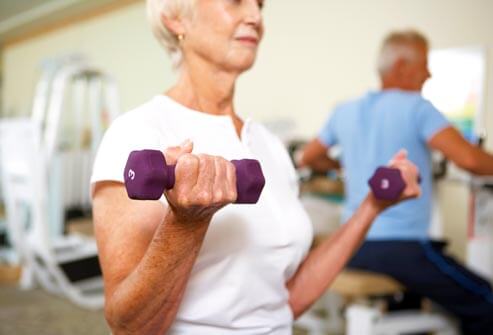Lift weight to lose weight
 It’s officially resolution season, and once again weight loss can be assumed to be one of the most common goals of the new year. If trying to work toward your ideal body weight is in your sights for 2019, then consider an alternative to some of the methods you may have tried in the past. Although diet and aerobic exercise are traditional staples in a weight loss program, research has demonstrated that strength training holds great benefit in shedding pounds and can in some cases be even more effective than aerobic and diet programs.
It’s officially resolution season, and once again weight loss can be assumed to be one of the most common goals of the new year. If trying to work toward your ideal body weight is in your sights for 2019, then consider an alternative to some of the methods you may have tried in the past. Although diet and aerobic exercise are traditional staples in a weight loss program, research has demonstrated that strength training holds great benefit in shedding pounds and can in some cases be even more effective than aerobic and diet programs.
We are all familiar with the formula: To lose weight, you have to burn more calories than you take in. The equation may be simple, but the real life application can be difficult. Typically, we focus our weight loss program in the realm of aerobic or “cardio” exercises (jogging, cycling, swimming, etc.), which indeed can produce good caloric consumption. In the process, however, your body will often break down fats as well as muscle to provide the energy for such exercise. If you aren’t working to maintain good muscle mass, you are doing yourself a disservice in your weight loss endeavors.
Muscle tissue is highly metabolic, meaning that it consumes calories at a high rate. The more muscle you have on your body, the more calories you will burn. This applies even when you are at rest and the muscle isn’t being stressed—it is consuming calories simply to exist.
Your base metabolic rate (BMR) is a measure of how many calories you burn just to maintain normal function, and a body with more muscle mass has a greater BMR than one with less. So on those off days, rest days or “cheat days” where you may not be getting a workout in, your muscle tissue is still at work burning calories.
So if a strength training program designed to build muscle tissue will give your metabolism a boost and stoke the fires of weight loss, why don’t more people think of it as a necessary part of their program? It may have something to do with some misconceptions about strength training. Many people equate “muscle building” with “bulking up” and are fearful that instead of looking trimmer, their muscles will stretch their clothes to the next size up. The good news is that, unless you are dedicated to a very specific regimen emphasizing high volume muscle hypertrophy, that isn’t going to happen.
Another misconception is that strength training will increase your body weight. Again, unless that is a designed goal in your program, it’s unlikely to occur. It’s true that muscle does weigh more than fat, so as you gain muscle the scale may not fluctuate a lot at first. But muscle is also a lot leaner than fat. So as your body burns fat and creates muscle, you’ll see the benefits in how lean you look and how clothes fit.
Admittedly, the title of this article is somewhat misleading in that strength training doesn’t need to be lifting weights. Body weight resistance exercise—squats, push ups, pull ups, lunges, dynamic abdominal exercises—are considered strength training elements as well. Whether you are doing your strength training at home with no equipment, using bands and light weights, or using heavier resistance with weights at the gym, the goal of strength training is to elicit muscular exhaustion. Working a muscle to its capacity so as to create targeted muscle fatigue is what stimulates the cycle of muscle tissue breakdown, repair and rebuilding.
The sets and repetitions required to meet this demand will depend on the amount of resistance you are using. So whether you are using light resistance and high repetition or heavy resistance and low repetition, the exhaustion effect is the goal.
To raise your heart rate during your strength training program, which in turn increases energy demands and burns more calories, take shorter rest periods between sets or perform exercises in a circuit. Work in quick bursts (30 seconds) of cardio (jumping rope, jumping jacks, air squats, jogging in place) between sets of your strength exercises to intensify the effect.
If weight loss is a goal of yours this year, try something different. Cardio/aerobic exercise is excellent and has its own list of benefits that cannot be discounted. Likewise proper nutrition is essential in lasting weight control. So as you build your plan of attack for 2019, consider adding strength training to those staples for the most effective program. The science supports it, and your results will show.
Timothy Gould holds a doctorate in physical therapy from SUNY Upstate Medical University in Syracuse, New York, and works at Dee Physical Therapy in Shelburne. He can be reached via email.
